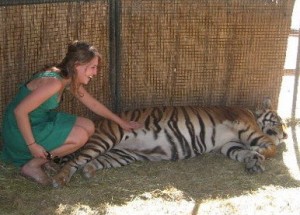Thailand’s petting zoos: More harm than help?
 Friends seem disappointed when I admit to skipping out on Thailand’s famed Tiger parks, or interactive zoos where tourists can safely cuddle up to entire tiger families. The photos are pretty cute, and there were plenty of times when I was certainly tempted. Now back in the US, I’ve become determined to uncover the truth about Tiger Temple, Tiger Kingdom, and all of the other hotspots for tiger-petting that I missed. What’s the catch? How are these trainers keeping the usually dangerous animals docile, unfazed by swarms of tourists creeping close for the perfect photo op? Are tigers truly safer in captivity, away from dangers of deforestation and poaching, or is this another case of animal exploitation for tourist dollars?
Friends seem disappointed when I admit to skipping out on Thailand’s famed Tiger parks, or interactive zoos where tourists can safely cuddle up to entire tiger families. The photos are pretty cute, and there were plenty of times when I was certainly tempted. Now back in the US, I’ve become determined to uncover the truth about Tiger Temple, Tiger Kingdom, and all of the other hotspots for tiger-petting that I missed. What’s the catch? How are these trainers keeping the usually dangerous animals docile, unfazed by swarms of tourists creeping close for the perfect photo op? Are tigers truly safer in captivity, away from dangers of deforestation and poaching, or is this another case of animal exploitation for tourist dollars?
Having visited Argentina’s Zoo Lujan petting zoo in 2007, I can tell you that posing with a tiger is truly a thrill. I was giggling away with my camera, and I admit that the photos from that day at the “zoo” are some of my most unique. They certainly evoked the most questions. Of course I second guessed the sincerity of the zoo’s mission statement, especially when the teenage zookeepers insisted that the tigers (many of them full grown males) were not drugged, but “raised with love.”
One of Thailand’s parks in particular has caught the attention of conscious travelers hoping to play with tigers and also help them. Animal conservation groups and concerned travelers, on the other hand, are trying to bring down Tiger Temple for good.
Just outside of Bangkok, Tiger Temple is the oldest Buddhist school and forest temple in Western Thailand. It’s a sanctuary that began caring for tiger cubs whose mothers had been killed, and they begin taming the animals starting at just three weeks. Their tiger population continued to grow through rescue missions and on-site breeding and now there are over 90. The entrance fee is about $20, and for $30 you can take a photo with one.
The park’s mission is to raise enough tigers to eventually begin releasing them into Thailand’s forests, and to also educate people on deforestation and poaching, but many animal activists groups and confused visitors find this suspicious. Care for the Wild International claims that the Tiger Temple is involved with animal trafficking, and other critics suggest that sedatives and abuse are to blame for the their suspiciously calm temperaments. The monks in charge continue to insist that the animals are safer there; that Tiger Temple is a sanctuary that keeps them healthy and safe.
A trip to Thailand’s zoos, parks, and interactive animal attractions are tempting, but don’t forget to do your research. Have any of you visited Tiger parks in Thailand? Do you have a different opinion?
Here are some fabulous resources to check out before signing up for an animal tour in Thailand, or anywhere else in the world!


June 12th, 2012 at 6:18 pm
The idea of a tiger petting zoo strikes me as depressing — and from a vagabonding perspective it feels like the epitome of an unearned, superficial, “exotic photo-op” experience. But I’d be willing to entertain a counter-perspective, should someone have found broader merit in these kinds of operations.
June 13th, 2012 at 8:47 am
Yes, it is depressing. it’s like posing for a photo with one of those sad-eyed Amazonian Indians in native costume in their jungle village, now surviving as a tourist attraction. Something that was once real and beautiful, now prostituted.
Perhaps, when all the costs and benefits are reckoned out, there is some net benefit to the great cats. There is much to be said for survival and perhaps it is romantic to object to something that might save them and we know that in other countries they do things differently. And I suppose it is impractical for them to be out there eating people.
June 14th, 2012 at 3:37 am
Although I decided against going to the tiger temple when I was in Bangkok a few years ago I don’t necessarily think the place is unethical or without merit. Some of my veterinarian friends went and enjoyed the opportunity to get so close to such amazing beasts. They weren’t entirely sure that the tigers weren’t sedated, which was a concern for them, but the tigers certainly didn’t display any behavior that would suggest physical abuse.
I think there is a place for captive animals, particularly if they have been orphaned or born in captivity. I’m against going out and capturing wild animals, except in instances where captive breeding is needed to conserve a species. Some people have the notion that all animals should roam free and forget that nature is often brutal. Tiger cubs that are orphaned are certain to die without human aid, and it’s usually not a quick and merciful death.
We can’t, nor should we save every wild orphaned animal (a lot of animals rely on carrion for sustenance), however if the goal is to provide a safe sanctuary whilst raising awareness and money for conservation efforts then I’m all for it. Of course I don’t know that this is entirely true for the tiger temple but one would hope so.
Interesting post Sarah!
AJ
Ps. Although I don’t think it’s particularly rewarding and not in the true spirit of vagabonding to seek out superficial photo ops I think I’ll check out the tiger temple next time I’m in Bangkok. Tigers are freakin awesome and I want to see the place for myself.
October 15th, 2013 at 5:44 am
I’ve been doing some research into zoo Lujan (which is how I came to this page), and I’ve got mixed feelings about it. I was initially skeptic, and concerned for the animals. But the zookeepers philosophy does seem sound. By raising the cubs to get used to human smells from birth, and by raising them together with dogs (who serve as an example), they convince the cats that they’re “family”. I’m not sure if it’s that much better for their wellbeing to live in a cage their whole life as a semi “wild” animal put on display, or to live as domesticated animals who get taken on walks and get plenty of love and attention. Despite my initial skeptisism I’m more and more drawn to the second idea. A documentary I saw about the zoo, which showcased bad things (the monkeys getting candy) as well as good, certainly implied the cats are happy there.
Ofcourse there’s a risk involved. But as no accidents have happened yet, their track record is pretty good. Most theme parks have had more incidents than the Lujan zoo.
I’m now cautiously optimistic about the Lujan zoo, but I can’t say much about the Thailand temple. Reports about that place certainly seem to imply some concern is justified.